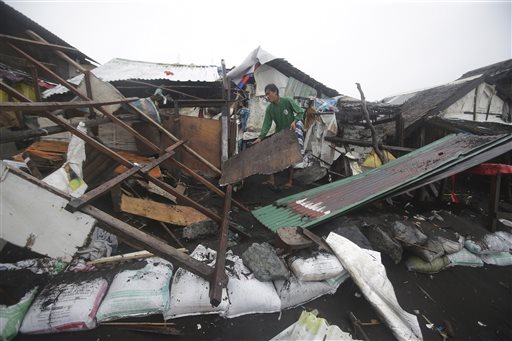
A Filipino man clears away debris from the remains of his damaged home as strong waves from Typhoon Hagupit battered a coastal village in Legazpi, Albay province, eastern Philippines on Monday, Dec. 8, 2014. AP
MANILA, Philippines – As Tropical Storm Ruby (international name Hagupit) wreaks havoc through the Philippines, Unicef is acting quickly to support the government’s response to the emergency, providing life-saving supplies and services for children and women in the areas hardest hit by strong winds and heavy rains.
Latest Government estimates indicate more than a million people have been affected, including over 400,000 children. Many of them are in evacuation sites.
Ruby is still on the move, bringing destructive winds, heavy rain, water surges and landslides despite the fact that it has further weakened. Its full impact is still not known.
“The Government’s swift evacuation response has saved many from injury and even death,” said Lotta Sylwander, Unicef Philippines Representative. “But Ruby is still a serious threat, and with tens of thousands of children and their mothers in urgent need of emergency aid, Unicef and partners are working around the clock to meet the many challenges.”
Unicef’s Tacloban office, established after Supertyphoon Yolanda (international name Haiyan), activated its emergency response plan last week. Its 54 staff are on standby to deploy to affected areas to undertake expert assessments, to work with the government and partners to assist evacuees. They are currently loading supply trucks to pre-position essential supplies and equipment from local warehouses to affected areas in Samar and beyond.
With poor sanitation and unclean water a direct threat to children’s health, restoration of existing water sources will be a top priority in the critical days after the storm. Unicef has supplies prepositioned in warehouses in Tacloban, Manila and Cotabato, including water kits, hygiene kits, water pumps, generators, water storage and treatment facilities.
Other emergency supplies include medical supplies, nutritional therapeutic food items to combat malnutrition, oral rehydration salts and tarpaulins power for at least 12,000 families.
Ruby made landfall only 13 months after Yolanda, which devastated parts of Eastern Visayas. Unicef’s efforts will focus on helping children overcome the effects of anxiety and extreme fear, including through the provision of psychosocial assistance.
School tents as well as education materials will also be provided so that children forced to evacuate, or whose schools have been closed or damaged by the storm, can continue learning.
“Thankfully, the typhoon has proven far less devastating than Yolanda to date, but there are still almost a million people – many still recovering from Yolanda – who have been driven from their homes,” said Sylwander. “These people have made enormous progress in rebuilding their lives over the last 12 months, and they need our help to make sure these hard-won gains are not washed away by this new disaster.”